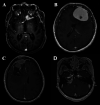Meningioma: A Review of Clinicopathological and Molecular Aspects
- PMID: 33194703
- PMCID: PMC7645220
- DOI: 10.3389/fonc.2020.579599
Meningioma: A Review of Clinicopathological and Molecular Aspects
Abstract
Meningiomas are the most the common primary brain tumors in adults, representing approximately a third of all intracranial neoplasms. They classically are found to be more common in females, with the exception of higher grades that have a predilection for males, and patients of older age. Meningiomas can also be seen as a spectrum of inherited syndromes such as neurofibromatosis 2 as well as ionizing radiation. In general, the 5-year survival for a WHO grade I meningioma exceeds 80%; however, survival is greatly reduced in anaplastic meningiomas. The standard of care for meningiomas in a surgically-accessible location is gross total resection. Radiation therapy is generally saved for atypical, anaplastic, recurrent, and surgically inaccessible benign meningiomas with a total dose of ~60 Gy. However, the method of radiation, regimen and timing is still evolving and is an area of active research with ongoing clinical trials. While there are currently no good adjuvant chemotherapeutic agents available, recent advances in the genomic and epigenomic landscape of meningiomas are being explored for potential targeted therapy.
Keywords: clinical trials; immunotherapy; meningioma; molecular diagnosis; neurosurgery; pathology; radiation therapy; targeted treatment.
Copyright © 2020 Huntoon, Toland and Dahiya.
Figures


References
Publication types
LinkOut - more resources
Full Text Sources
Research Materials

